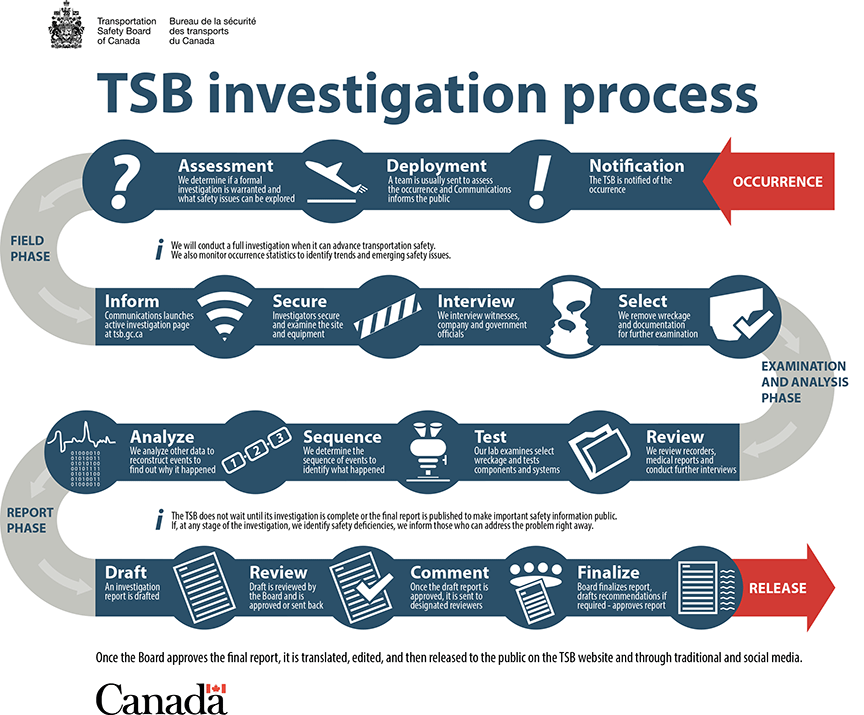Investigation process
Who we are
The Transportation Safety Board of Canada (TSB) is an independent agency that advances transportation safety by investigating marine, pipeline, rail, and aviation occurrences, and communicating risks in the transportation system. The TSB does not assign fault or determine civil or criminal liability, and its findings cannot be used in legal or disciplinary proceedings. Coroners and medical examiners, however, may use TSB findings in their investigations.
What we do
Each year, about 3200 transportation occurrences (accidents and incidents) are reported to the TSB; they vary hugely, from aircraft part failures and ship fires to pipeline ruptures and train derailments. When the TSB is notified of an occurrence, it assesses the circumstances to determine if an investigation is warranted. A TSB investigation team may be deployed to the occurrence site to carry out the assessment.
The TSB investigates an occurrence when there is a high probability that it can advance transportation safety and reduce risks to persons, property or the environment (see the Occurrence Classification Policy). Although the TSB primarily investigates occurrences in Canada, it does assist in foreign investigations from time to time.
The TSB also monitors occurrence statistics to identify trends and emerging safety issues. It reviews developments in transportation safety and identifies safety risks that it believes government and the transportation industry should address to reduce injury and loss of life.
Our resources
The TSB has five board members including a chairperson (the Board), as well as some 220 employees nationwide. Its head office is in Gatineau, Quebec, and its engineering laboratory is in Ottawa, Ontario (see the organizational structure). With investigators in eight regional offices, the TSB can respond quickly to transportation occurrences anywhere in the country.
Our methodology
There are three phases to a TSB investigation: the field phase, the examination and analysis phase, and the report phase.
Field phase
Once the decision has been made to investigate, an investigator-in-charge (IIC) is appointed and an investigation team is formed. The nature of the occurrence determines the makeup of the investigation team, but it can comprise operations, equipment, maintenance, engineering, scientific, and human performance experts. The number of investigators sent to an occurrence site depends on the investigation.
During the field phase, investigation team members generally:
- inform the public of TSB’s deployment to the occurrence site;
- secure and examine the occurrence site;
- examine and photograph the equipment, vehicle or wreckage;
- interview witnesses and company and government personnel;
- select and remove wreckage for further examination; and
- review documentation.
Examination and analysis phase
Much of the investigation takes place after the TSB investigation team leaves the occurrence site. During the examination and analysis phase, the TSB may:
- examine company, vehicle, government and other records;
- examine selected wreckage in the laboratory and test selected components and systems;
- read and analyze recorders and other data;
- create simulations and reconstruct events;
- review autopsy and toxicology reports;
- conduct further interviews;
- determine the sequence of events;
- identify safety deficiencies; and
- update the public on the investigation.
The TSB does not wait until its investigation is complete or the final report is published to make important safety information public. If, at any stage of the investigation, the TSB identifies safety deficiencies, it informs those who can address the problem right away.
Report phase
After the examination and analysis phase, an investigation report is drafted. The Board reviews the draft report: it may approve it, ask for minor amendments, or return it for further work. Once the draft report is approved, it is sent to designated reviewers on a confidential basis for comment.
A designated reviewer may be any person—including a company, corporation, manufacturer or association—who, in the opinion of the Board, will contribute to the completeness and accuracy of the report.
The Board considers all the designated reviewers’ comments and amends the report as required. Once the Board approves the final report, it is released to the public on the TSB website and through traditional and social media.
The TSB publishes its investigation reports as quickly as possible, but it takes the time it needs to conduct a thorough investigation and produce a report that advances safety and meets the expectations of the Canadian public and the transportation industry.
Who is involved in a TSB investigation?
Many individuals and groups collaborate with the TSB in fulfilling its mandate. During an investigation, the TSB works with all levels of government, transportation companies, equipment manufacturers, and individuals such as survivors, witnesses, next of kin, and operators. The TSB also works with coroners and medical examiners, police, fire departments, and search-and-rescue teams (see how first responders support TSB investigations). Collaboration at all levels is essential for the TSB to carry out its mandate.
Survivors and next of kin
When fatalities occur, responsibility for informing the next of kin falls to the police, the coroner/medical examiner, or the transportation company. The TSB keeps survivors and next of kin informed about the process and progress of its investigation, and briefs them on the final report before it is released to the public and the media.
Witnesses and others with knowledge related to the occurrence
TSB investigators interview anyone who can assist them with the investigation. If you are asked to provide information, you may wish to have someone accompany you (find out more about being interviewed by the TSB).
Observers
The TSB may grant observer status to persons with a direct interest in the subject matter of the investigation who can potentially contribute to the advancement of transportation safety. Observers usually come from transportation companies, equipment manufacturers, and regulatory agencies. They attend investigations, under the supervision of an investigator and in accordance with TSB rules.
Investigation information
Information collected during an investigation, including on-board recordings, representations to the TSB, and personal information such as witness statements, is protected under the Canadian Transportation Accident Investigation and Safety Board Act.
